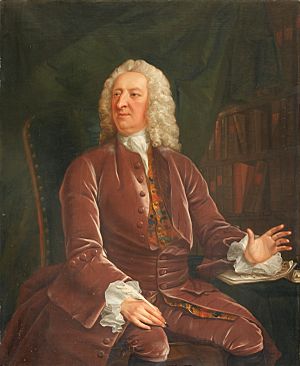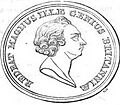William King (academic) facts for kids
William King (born March 16, 1685 – died December 30, 1763) was an English scholar and writer. He was the head of St Mary Hall, Oxford starting in 1719. King was known for his strong support of the Jacobite cause, which aimed to bring the Stuart family back to the throne. He was also a talented writer of satire and poetry.
Contents
Early Life and Education
William King was born in Stepney, Middlesex, England, on March 16, 1685. His father was Reverend Peregrine King. William went to Salisbury grammar school. Later, he attended Balliol College, Oxford, starting in 1701. He earned his first law degree in 1709 and a higher law degree in 1715.
In 1712, he became a lawyer at Gray's Inn. He was also admitted as a civilian lawyer in 1716. However, because he had his own money, he never needed to work as a lawyer.
Life at Oxford University
King spent his life studying and writing. He was very interested in politics and was seen as a leader of the Jacobite group at Oxford University. He worked closely with Sir John Hynde Cotton, 3rd Baronet. King used shocking methods to get attention for his political ideas.
For a while, King worked as a secretary for the Duke of Ormonde and the Earl of Arran. Both of them were leaders of Oxford University. In 1719, King was chosen as the head of St Mary Hall. He stopped being a secretary in 1722 when he tried to become a Member of Parliament for the university. However, he lost the election. St Mary Hall did not have many students, but one who learned from King was Sanderson Miller.
King's Connections and Writings
In 1727, King traveled to Ireland for a legal case about an estate. He became friends with the famous writer Jonathan Swift. In 1739, Swift asked King to publish some of his poems in London. King was worried about parts of the poem that made fun of important people like Robert Walpole and Queen Caroline. So, he removed over a hundred lines. This made Swift upset, but King explained he did it to protect Swift.
Around the same time, King met Nathaniel Hooke and helped him write down his translation of a book called Travels of Cyrus.
In 1746, King welcomed William Lauder to Oxford. Lauder was later found to be a literary forger, meaning he faked parts of writings. King liked Lauder's political views. Other scholars, including Roger Watkins from St Mary Hall, later proved Lauder was dishonest.
Meeting the Pretender and Political Challenges
In September 1750, King met Charles Edward Stuart, also known as the "Young Pretender." The Pretender was secretly visiting England and had tea with King in Oxford. They wrote letters to each other, but King eventually grew to dislike him.
King was involved in a difficult election in Oxfordshire in 1754. Because of this, he was strongly criticized in public. People accused him of cheating people out of money for books he never published. They also said he tried to sell his loyalty to different groups. In February 1755, King gave Samuel Johnson his Master of Arts degree. Johnson admired King's knowledge and political views.
Later Years and Legacy
In 1761, King publicly ended his connection with the Jacobite party. He joined a group from the university to congratulate George III on his marriage. He was personally introduced to the king.
King passed away on December 30, 1763. He was buried on January 5, 1764, in Ealing, Middlesex, where he had lived for many years. He was known for only drinking water throughout his life. His heart was placed in a silver urn and put in the chapel of St Mary Hall, as he wished. There is a monument there with a Latin message he wrote himself.
King's Speeches and Public Life
William King was famous in his time for being a fiery speaker. He enjoyed causing debate and controversy. In 1743, when honorary degrees were given to important people at Oxford, King gave Latin speeches. These speeches were later published. He seemed to enjoy the arguments that followed. King even wrote a fake letter criticizing himself to keep the public interested!
On April 13, 1749, King gave another Latin speech at the opening of the Radcliffe Camera, a famous library building. In this speech, he showed his Jacobite beliefs by repeating the word redeat ("that he may return") six times. Each time, the audience cheered loudly. This speech was very popular with Jacobite supporters.
When a new leader was chosen for Oxford University in 1759, King gave another speech. Samuel Johnson clapped so hard his hands hurt, according to his friend Boswell. In 1763, King gave one more speech that was met with great applause.
Published Works
King felt unfairly treated during his legal case in Ireland. He wrote a long, funny poem called The Toast to criticize his enemies. The poem was first published in Dublin in 1732. Jonathan Swift liked it. King later expanded it, but in his old age, he regretted some parts. After his death, the remaining copies of the poem were burned.
Around 1737, King wrote a clever political paper called Common Sense. In it, he suggested a new way of governing for the people of Corsica (which was a hidden way of talking about Great Britain). He sent a copy to Swift, but it was stopped in the mail.
After the Jacobite Rebellion of 1745, King made a comment about Prince William, Duke of Cumberland, saying he was a man "who fears everything except God." In 1748, King made fun of Edward Bentham, who had written a guide for new students.
King's speech at the Sheldonian Theatre was printed in 1749. It led to strong criticism. People said his Latin was bad, and that he was spreading Jacobite ideas and causing trouble at the university. King responded fiercely to these attacks.
In 1754, King published a book of imaginative essays called The Dreamer. This book was also criticized by those who opposed the Jacobites. In 1755, he wrote a pamphlet to defend himself against more public attacks.
A collection of his writings was published in 1760. King also wrote an inscription for statues given to the university in 1756. He wrote a tribute to an eye doctor in 1758 and an epitaph for Beau Nash, a famous social leader. After he died, his Political and Literary Anecdotes of his own Times was published in 1818.
Improvements to St Mary Hall
With help from former students of St Mary Hall, King rebuilt the east side of the main courtyard. He also added a new room to the principal's living quarters.
Family Life
William King married his cousin, Henrietta Maria Wither, in 1709. Their son, Charles King, born around 1711, also studied at St Mary Hall and became a clergyman. Their daughter Dorothy married William Melmoth the younger.
Images for kids
-
An engraving by Thomas Worlidge showing the Sheldonian Theatre during the 1759 ceremony for the new Chancellor of Oxford University.
-
William King, from a 1760 engraving by Thomas Hudson.





